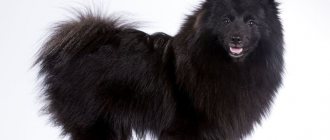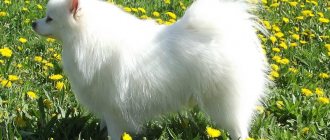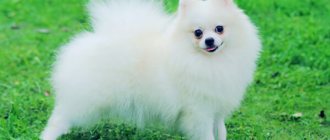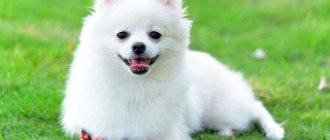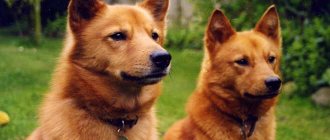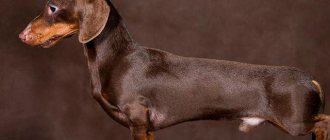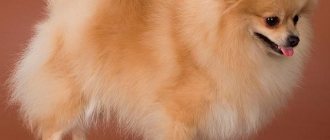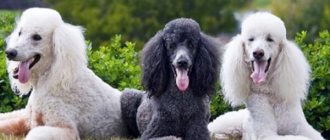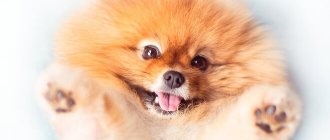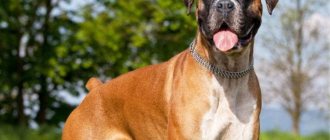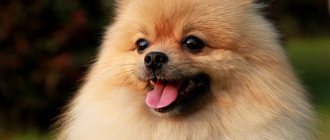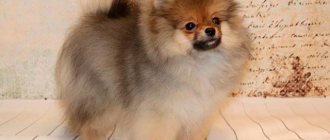| Origin: | Germany |
| Usage: | companion, watchman |
| Color: | various |
| Dimensions: | 20-55 cm |
| Lifespan: | 15 years |
The German Spitz is absolutely charming. He resembles a cross between a fox, a bear cub and a lion. And behind the sweet appearance hides a fearless guard, a curious mischief-maker and an understanding companion. This fur ball with triangular ears and beady eyes has captivated thousands of people since ancient Rome and continues to win the love of millions of dog lovers today.
Features of the German Spitz breed
In ancient times, large German Spitz dogs were used as guards, herding sheep, and guarding houses. The breed was formed without human intervention until the 18th century. Later, Spitz dogs gained recognition among court ladies as a decorative breed.
The dogs were larger than modern representatives. They captivated their owners with their intelligence, loyalty, easy-going nature and cheerful disposition. At the same time, being good watchmen and security guards, German Spitz dogs were cute and playful.
Thick, beautiful coat protects the dog from the cold. The dog tolerates high humidity well. He enjoys playing outside and running after toys. Easy to train, loves to swim in the water.
The dog is smart and smart. Attached to the owner with all her soul. Security and watchdog qualities are at a high level even in the smallest representatives of the breed. The dog's calm and balanced character allows him to get along with children and other animals.
Dwarf German cuties retain the same qualities as large dogs.
History of appearance
Representatives of the European peat or swamp dog are recognized as the ancestor of the breed. Their distant ancestors are visible in images from the times of Ancient Greece and Ancient Rome. They were larger than modern specimens, but smaller than other guard and herding dogs. They did not take up much space, ate little, and were faithful and devoted to their owners. This earned them a place in people's hearts.
Ancient representatives of the breed gradually moved throughout Europe at different stages of development. Historical roots arose in Scandinavia, along the entire coast of the Baltic Sea, reached the southern part of Europe, crossed the English Channel and ended up in Great Britain.
Actual country of origin of the breed
The remains of the ancestor of the Neolithic peat dog were discovered during excavations in the territory of modern Switzerland. This is the oldest breed on the European continent.
The name was assigned to the dogs only thanks to the breeding and development of the breed in Germany in the 18th century. The first breeding work was carried out in Denmark and Holland in the 16th century. In fact, one of the Scandinavian countries should be considered the birthplace of the breed.
Difference from the Pomeranian
The Pomeranian dwarf was bred much later than its large and medium-sized relatives. Queen Victoria of Great Britain began work on breeding dwarf dogs at the end of the 19th century. The final standard for miniature oranges was formed only in the middle of the last century.
Story
According to experts, German Spitz are one of the most ancient dog breeds, which dates back 2 and a half thousand years. It appeared in the Stone Age in Central Europe and is known as the first peat dog.
A dog for the poor
The size of the German Spitz, by the Renaissance period, decreased significantly, as evidenced by the drawings of dogs on various household items that have come down to us from the distant Middle Ages.
These small-sized dogs initially served poor people, protecting them, as well as their farmstead, from large dogs with great courage, while they were not so voracious compared to large dogs.
After some time, the more prosperous sections of the population appreciated both the watchdog qualities and a more limited appetite. After this, such dogs began to successfully guard plantations, rich yards, and also help shepherds protect livestock from various predators.
Dog for the rich
The richest people appreciated these animals only in the 18th century in Germany, where certain regions were breeding their own types of Spitz, which did not go unnoticed among the European nobility.
As a result, Spitz “occupied” the whole of Europe, while the most sought-after individuals were pure white, but animals of brown and red shades were not so highly valued.
In the 19th century, this breed appeared in the USA, after which the English Spitz Fanciers Club appeared, and this entailed the organization of various exhibition shows. In 1891, the first breed standards were published, divided into 2 groups: the first group included animals weighing up to 2.5 kilograms, and the second group included individuals whose weight was more than 2.5 kilograms.
Today, American Pomeranians are considered the best on our Planet.
Appearance of the breed in Russia
In our country, this breed appeared at the end of the century before last, and their owners turned out to be very wealthy people, which is why “Napoleons” were considered an integral attribute of the bourgeoisie. In addition to keeping them, they were also involved in their breeding, and in each province there were Spitz dogs that differed in some features, both in their behavior and in their appearance.
At the beginning of the last century, there were already 3 groups of representatives of this breed. Exhibitions were organized in large cities of the Russian Empire, where at least 50 German Spitz dogs took part.
The World Wars had a major impact on the overall number of German Spitz dogs, significantly reducing their numbers. Currently, these animals are in great demand both among clients and breeders. This is due to the fact that in Russia there are individuals of this breed that meet all international standards.
Pet Zoo: German Spitz
Description of breed standards
The International Canine Federation recognizes 5 standards for the German Spitz breed:
- large or wolfish;
- big;
- average;
- small;
- dwarf.
Height varies from 18 cm to 50 cm. The weight of a large purebred male reaches 30 kg, girls are slightly less. A dwarf orange weighs on average about 2 kg.
Despite significant differences in height and weight, the basic breed standards are typical for all representatives of German Spitz.
The body is square, compact, proportional to height. The chest is powerful and convex. The abdomen is retracted, the neck is medium-short, widening towards the base. The paws are straight, the pads are rounded, tightly compressed, the claws and pads are black (except for brown).
The muzzle is slightly elongated, pointed towards the nose, similar to a fox. The eyes are round, black (except for brown), slightly oblique. The ears are erect, triangle-shaped, and set high. There are 42 teeth; Pomeranians may have no premolars; they have a scissor bite. The black lips are smooth, pressed tightly to the teeth, without jowls.
The tail is curled and lies on the back. The guard coat is long, straight, with a dense, dense undercoat. The movements are confident and springy.
Standards for the exhibition
A dog may not be allowed to attend the exhibition:
- cowardly or, conversely, too aggressive;
- with defects in appearance;
- with behavioral disorders;
- with bulging eyes;
- with an unovergrown fontanel;
- with any malocclusion;
- with non-standing ears;
- with a nose, lips and eyelids that are not black (or brown);
- with the absence of the correct pattern on the face of the Keeshond;
- with non-standard colors not included in the breed list.
Distinctive features
All dogs of this species, regardless of type, according to FCI standards, must meet the following indicators:
- The head is wedge-shaped, of medium length, tapering towards the lobe, but not sharp, with a clear stop. The length of the muzzle relates to the dimensions of the skull as 2 to 4 (for the miniature type), as 2 to 3 (for the rest) .
- The nose is small, circle-shaped, black. For animals with brown topcoat, the tone matches the color.
- The bite is scissors, but a pincer bite is acceptable. There are 42 teeth (for the Pomeranian, the absence of part of the premolars is allowed).
- The eyes are almond-shaped, dark, slightly oblique, medium in size.
- The neck has a curve at the nape, is of moderate length, broad at the base.
- The ears are small, erect, in the form of a triangle, closely spaced. Features a high rise.
- The tail is in the form of a single (or double) dense ring, adjacent to the spine. The length is moderate.
- The body is light, the upper part forms an arch from the high withers to the back. The spine is straight, the croup is not sloping. The back is short, with a wide loin, and correlates with the height at the withers as 1 to 1 . The sternum is deep, elongated as much as possible. The lower part is slightly pulled up.
- The legs are very muscular and straight. The elbow joints are pressed to the sternum, the metacarpus are located at an angle of 20 degrees , the metatarsus is vertical. The paws are small, cat-type (round), the pads are firmly assembled, the color is similar to the claws, the front legs are black, the hind legs are as dark as possible. In dogs with brown fur, their tone matches their color.
- Coat with thick undercoat and long top hair. The covering part is located straight, not adjacent to the skin. The hair on the face, ears, paws and the front of the limbs is short. The remaining areas of the body with a pronounced hair length do not form a parting. There are “pants” on the hind legs, all limbs in the rear area have feathers. The tail is heavily pubescent and has a thick “mane”. There should be no signs of yellowness on the white coat.
- The mucous membrane of the lips and the rim of the eyes are black, for brown dogs the color is similar.
Colors and what a German Spitz looks like and puppies of this breed
Long hair with a thick, dense undercoat is the main advantage of the German Spitz. Depending on the size of the dog, acceptable colors range from white to black. The Wolfspitz is the largest representative of the breed and comes in only one color – wolf grey-zoned. The Grossspitz has three coat colors: white, brown and black. Medium, small and dwarf Spitz representatives have white, cream, red, brown, bi-color, black, gray-fawn, black-fawn and tri-color. Sable, brindle and merle colors are allowed in oranges.
The fluffy collar on the neck and fluffy pants on the hind legs distinguish all varieties of German Spitz from other dog breeds.
The final coat color of complex colors is formed only after the first molt. Puppies of gray-fawn, black-fawn, as well as red, beige and black colors often do not have an even color for the first three months of life. Only by 4-6 months the color changes to standard. The puppy begins to look like a German Spitz, taking on the features of a dog of its own breed.
For a two-color and three-color pet, the main color is always white.
White color
The most popular color remains white. According to standards, the color should be even without darkening, without islands of beige color, impurities and individual hairs of other colors. Only a light cream shade behind the ears is acceptable.
Among Spitz dogs of all categories, white German “fluffies” are in demand in large, medium and small groups, despite the difficult care of their coat and the peculiarities of keeping it clean.
Keeping the white fur squeaky clean is made difficult by the fact that it is not recommended to bathe the animal often. Buying clothes, shoes, special dry shampoos for washing your pet will become an additional expense. But this does not stop lovers of white color.
The appearance of an absolutely white coat gives the dog a noble, aristocratic appearance. Only the nose, eyes and claws are painted black. Since ancient times, white has remained the most popular color.
Black color
The black color of the coat attracts with its monotony. Completely black individuals are amazingly beautiful and attractive. Deep black has become a popular color for the German Spitz breed. Exhibition specimens are completely black, including the nose, eyes, claws and paw pads, looking impressive.
Red color
The peculiarity of the red or orange color is its real rich manifestation after the dog’s first molt. Until this time, the puppy's coat color may appear lighter than the usual orange shade. The undercoat will also not immediately meet exhibition requirements.
According to breed standards, the collar, top of the hind legs and tail may be lighter than the base tone.
Sable color
Sable dogs are very attractive. Transitions of gray, dark gray and blue shades create the effect of sable skin. The color is not recognized as an exhibition option in all countries.
Other colors
If the Keeshond is allowed for exhibitions only in one color, silver-gray, then the variety of colors of the medium, small and dwarf German Spitz is represented by gray, brown, cream shades and spotted multi-colors.
For brown dogs, an exception is made for the color of the nose, eyes, and claws. They should be the same color as the fur - brown.
Spotted coloration refers to individual spots of color on a mostly white background. The stains should be uniform in color, without inclusions.
Adult Japanese Spitz
The snow-white beauty is distinguished not only by its amazing color, but also by its dislike of barking. The pet uses its voice extremely rarely, only when necessary. A Japanese adult can be an excellent nanny, as he loves children and is willing to spend a lot of time with them. The dog is kind, active, able to create a positive atmosphere in the house, and playful.
The size of an adult Japanese Spitz varies from 35 to 40 cm at the withers. The dog weighs from 6 to 10 kg.
Features of behavior
The balanced character of the German Spitz is especially noticeable among representatives of large species. Small and dwarf pets are more emotional. But by paying attention to raising a pet and corrective classes, an excellent result is achieved in adapting the animal to life in society.
Usually a German Spitz behaves warily with a stranger and does not allow him to approach his owner. Without proper training, a dog can become aggressive, scare away by barking, and even attack a stranger, trying to bite. We must not forget that the genetics of the breed are dominated not by decorative qualities, but by protective qualities.
German Spitz attitude towards children
The cute, good-natured appearance of the dwarf Spitz is misleading. You want to hug the dog and ruffle its soft fur. The idea that such treatment of an animal is possible is erroneous. The free and proud character of the German Spitz requires respectful treatment regardless of size.
A child unknowingly mistaking a small dog for a soft toy can cause the dog to defend itself. Small children should not be left alone with a German Spitz without supervision. The dog will quickly find a common language with the owner’s child and will put up with his pranks, but within reasonable limits. Children should not play with someone else's dog to avoid getting into trouble.
Adult Italian Spitz, or Volpino
This small, extremely playful dog has a restless character. The Italian is very emotional and reacts to all events with a loud bark. But good nature and responsiveness allow you to close your eyes to the overly absurd temperament of your four-legged friend.
The size of an adult Volpino varies from 25 to 30 cm at the withers. The dog weighs no more than 5 kg.
Character and habits of German Spitz
The Spitz's cheerful and good-natured disposition has made him popular all over the world. When getting a furry pet, you need to take into account the characteristics of its character.
The dog's active temperament requires long walks and physical activity.
The devotion of German Spitz dogs is so great that, being without their owner for a long time, they can get sick from boredom.
The puppy is smart, easy to train, and quickly remembers commands. The guard and watchman skills of this breed have been preserved even after several centuries of breeding work.
Health and life expectancy
Dogs of this breed have fairly good health. The main thing is proper care of your pet, mandatory vaccination and timely treatment for helminths.
Spitz dogs are susceptible to some breed-specific diseases:
- eye diseases: glaucoma, retinal atrophy, cataracts, eyeball loss, severe lacrimation;
- hip dysplasia;
- hypothyroidism;
- von Willebrand disease;
- epilepsy;
- dislocation of the kneecap;
- tartar.
The life expectancy of German Spitz depends on the type of pet and ranges from 7 to 15 years.
A healthy Spitz is active and energetic
Maintenance and care
Cute German “charms” are suitable for keeping in an apartment or in a house. They do not take up much space and find a common language with other animals.
The decorative German dog needs constant care. For this, hygiene items are purchased: a comb, a slicker brush, a nail clipper, a nail file, a warm blanket for a place or a mattress bought in a store, shampoo, conditioner, lotion for treating ears, eye cleanser, bowls for food and water, toys.
The decorative German small Spitz requires a more responsible approach to maintenance and care than its large and medium-sized relatives.
Diet
During the first 2-3 weeks of the puppy’s adaptation to new conditions, it is advisable to feed the baby the food that he is accustomed to in the kennel, gradually introducing into the diet the foods that you are going to feed the dog.
It is advisable to feed a 2-4 month old puppy every 4 hours. From the age of 5 months, you need to transfer the puppy to 4 meals a day. From 8 months, it is already enough for a Spitz to eat 3 times a day. From the age of 1 year, the dog should switch to a 2-time feeding regimen.
Spitzes need to add raw and boiled vegetables, raw meat, cereals, sea fish and cottage cheese to their diet. Or switch to ready-made balanced premium food.
Overfeeding a dog is unacceptable. It can lead to obesity in your pet, and even undermine its health.
Maintaining the physical condition of the German Spitz is important to maintaining the breed standard, which is facilitated by a strict feeding schedule and a balanced diet.
Wool and care
The main advantage of the German Spitz is considered to be its thick, long hair with a dense undercoat, which gives the animal a cute and attractive appearance. The coat needs constant care.
It is advisable to comb the German “handsome” at least once a week with a slicker brush and a wide-toothed comb. During autumn and spring shedding, you can scratch it daily with a massage brush or slicker brush.
It is imperative to monitor the appearance of tangles and promptly cut or comb out stuck together lumps of hair. Excessive hair loss and the appearance of bald patches can serve as a signal to change your diet. Long-term hair loss and the appearance of bald spots on the skin indicate serious disturbances in the functioning of the body and health problems. You should contact your veterinarian for advice and treatment.
The owner needs to accustom the puppy to the comb as early as possible, so that in the future the procedure does not bring unpleasant moments.
Haircut and grooming
The coat of the German Spitz is capricious. Damage to the undercoat threatens to disrupt hair growth. Grooming and complex haircuts are best left to a specialist. Especially before the exhibition. You can independently trim protruding hairs and simply trim small tangles.
Eye care
The black button eyes (or brown ones of the same color) give a special charm to the face of the German Spitz. Spitz eyes are indicators of the dog’s health. A little tearing is acceptable and does not cause concern about the health of the pet. It is enough to wipe your eyes daily with special products. Excessive tearing indicates a disruption in the functioning of the body. It can be caused by allergies, poor diet, poor gastrointestinal function and retinal detachment. This is a signal to contact the veterinarian.
Teeth and health
The German Spitz has large and medium-sized teeth, very strong, and do not require additional care. Standard procedures and brushing your teeth with special edible bones are enough. Small representatives of German Spitz, including Pomeranians, require careful attention when changing baby teeth. The deep root system makes it difficult to form a correct bite. Sometimes veterinary intervention is necessary.
Tartar buildup can become a problem if you don't pay attention to brushing your German dog's teeth. It is recommended to start the procedure after the change of baby teeth, which ends at the age of 8-9 months.
Ear health
You should carefully monitor the condition of your German Spitz's ears. A daily inspection won't hurt. About once a week you need to wipe the ear with a cotton swab dipped in lotion. Clean your ears with special products and trim excess hairs.
Redness of the ear, restless behavior of the dog: head shaking or scratching of the ears are signs of ear diseases that require consultation with a veterinarian.
Nail care
The agility and speed of the German Spitz helps the larger representatives of the species maintain their claws in the desired shape. It is recommended to trim the nails once a month and sharpen them with a soft file. In dwarf dogs with small height and weight, the claws themselves do not grind down to the required length. Therefore, it is better to carry out trimming at least 3-4 times a month. Then carefully file away the sharp edges.
Water treatments
Frequent bathing has a bad effect on the condition of the animal’s skin and the thickness of the undercoat. A German “fluffy” can take a bath no more than once every two months or as needed. You should wipe your paws with a damp cloth after every walk. To prevent the pads from cracking due to dryness, you need to rub a softening lotion into the paws.
Walks
It is recommended to walk a puppy under 6 months of age 4-5 times a day. As you get older, the frequency of walking decreases. An adult dog is walked 2 times a day. Large and medium-sized Spitz can calmly tolerate an interval of 12 hours. The average duration of walks is from 40 minutes to 2 hours.
Dwarf German Spitz dogs, including Pomeranians, have a bladder that is too small. Long breaks between walks are not easy for dogs. If walking three times a day is not possible, then the way out would be to accustom the baby to a cat litter box or a disposable diaper.
Long one and a half hour walks are useful for an agile athlete who loves playing with a ball. The lively activity and mobility of the animal require constant loads. Having splashed out his energy on a walk, the dog will become calm and sweet at home.
Animal nutrition
You can feed the animal both natural products and prepared food. The main condition: choose one type of feeding and do not mix it with another.
The finished food should be Premium or Super-premium for decorative dog breeds. The portion per feeding depends on the age and weight of the pet and is usually indicated on the package. With this type of feeding, it is important that the dog drinks enough water.
When feeding natural products, the majority of the daily diet should consist of offal and boiled or scalded with boiling water dietary meat. You can diversify your diet with boiled sea fish fillets. It is better to mix meat or fish with cereals or vegetables. Seasonal fruits are allowed, with the exception of citrus fruits.
You should not give smoked, spicy or fried foods, any sweets, river fish or milk. Long bones are also prohibited as they can damage the dog's esophagus.
It is enough to feed an adult pet 2 times a day. Puppies up to three months of age are fed 5-6 times a day, by the age of ten months they are transferred to two meals a day, gradually reducing the number of feedings. It is advisable to eat at the same time every day.
Attention! The dog's food should be dietary so that problems with the gastrointestinal tract do not arise in the future.
Tendency to diseases
Dwarf varieties of German Spitz, in the selection of which attention was paid to appearance, are susceptible to certain types of diseases. These include: joint weakness, urolithiasis, gastrointestinal problems, laryngeal cough, eye abnormalities, skin diseases.
With proper attention to your pet's well-being, most health problems can be avoided. Constant observation by a veterinarian, proper nutrition, constant care and physical activity will make you forget about diseases.
Large representatives of the breed were least subjected to selection and retained excellent health. But care, prevention, and maintaining good physical shape are no less important to them than to their smaller relatives.
Adult Greenland dog
The Spitz of this breed is considered a sled dog. In the old days, Greenlanders were taken to hunt large northern animals. And although in recent years the need for this has decreased, representatives of the breed have not lost their courage, endurance, and daring temperament.
The size of an adult Greenland dog varies from 50 to 60 cm at the withers. Weighs from 30 to 32 kg.
Basics of training and behavior correction
A smart pet already from 6 months learns to carry out the owner’s basic commands. By the age of two, the dog becomes a full-fledged member of the family and a trained guard, knowing and following the commands “Come to me”, “Sit”, “Lie down”, “Voice”, “Near” and “Fu”.
It is possible to train in agility (optional), or overcoming dog obstacles. A penchant for play, quick learning, mobility, and a desire to dominate will lead your pet to achievements in an interesting, new direction of performance.
Early socialization of a German Spitz puppy will help relieve excess aggressiveness, teach him how to communicate with other dogs, and provide an outlet for energy.
For the German Spitz breed, the time spent on education and care will result in a calm, measured life with an obedient and healthy animal.
Training
The German Spitz is a dog that is quite capable of learning. This breed is easy to train and has the following qualities:
- remembers commands well and responds adequately to them;
- quickly masters circus and acrobatic tricks;
- easily obeys and recognizes the leadership of the owner.
Don't waste time and start training as early as 4 months. You should not punish your dog using physical force, as this will cause you to lose trust and damage your pet’s psyche.
German Spitz nurseries
The German Spitz breed is bred in three directions: pet class, brit class and show class. Before purchasing a puppy, it is important to decide for what purpose you are getting a pet. Dream of winning at exhibitions? Then you need to contact breeders who breed show-class dogs. If you want to breed German Spitz yourself, then you need to choose a dog from the Brit category. If you need a friend and companion, then you need to pay attention to puppies bred for pet standards.
You should only buy a puppy from trusted breeders.
Who is the dog suitable for?
Modern representatives of the breed are excellent companion dogs and guard dogs .
These energetic animals cannot stand loneliness and boredom , so they require a lot of attention and active walks. If you don't like long walks or sports activities, like to spend more time at home and don't like loud noises, this dog is definitely not for you.
If you love active sports, are willing to devote a lot of time to walks and training, and do not flinch from loud sounds, the Spitz will become your best friend and companion.
Some species are characterized by increased nervous excitability . When frightened, they may bark loudly or get into a fight.
Interesting fact: Spitz dogs are often used abroad in animal-assisted therapy. American psychotherapists, when working with withdrawn patients, often resort to their help.
For small children, such a dog will become a best friend with “nanny” functions. However, any contact with small family members must be controlled by the owner, since a child, through negligence, can cause pain and frighten the animal.
They also get along well with cats , dogs and other animals.
Spitz are very loyal to their owner, so a change of owner or environment can threaten the animal with a nervous breakdown.
Positive and negative characteristics
There are both positive and negative aspects in the character and behavior of the German Spitz. Before purchasing a puppy, you must carefully study all the nuances inherent in the chosen breed.
The advantages of German dogs include:
- active, curious, playful, disposition;
- devotion and fidelity;
- excellent security qualities;
- loyal attitude towards children and animals;
- obedient, easy to train;
- insensitive to weather conditions;
- adapts to the owner’s habits, sensitively capturing the person’s mood.
The disadvantages mean some features:
- barks a lot if behavior is not corrected;
- may show aggression towards strangers, which can be corrected by proper upbringing;
- strives to dominate;
- prone to certain types of diseases.
Characteristics of height and weight
There are 5 types of German classic representatives of the breed:
- Wolfspitz (Keeshond). The largest representative of the breed. It has only one acceptable coat color - zone-gray with silver and black transitions. The height at the withers of an adult male reaches 55 cm, and the weight reaches 30 kg.
- Grossspitz, or large German. Available in white, brown and black colors. Height at the withers is from 42 for a girl and up to 50 cm for a boy with an average weight of 15-18 kg.
- Mittelspitz, medium. The coat color can be white, red, brown, black, fawn-gray, fawn-black. Other colors allowed by the breed standard are also possible. It grows no higher than 35-40 cm, gaining weight no more than 11 kg.
- Kleinspitz, or small Spitz. The color includes all solid colors, bicolor and fawn. At the withers it grows to 23-29 cm and weighs between 8-10 kg.
- Miniature Spitz, dwarf or Pomeranian. Acceptable colors are white, cream, brown, gray-fawn, black-fawn, black, and bicolor. The American Canine Federation also recognizes sable, brindle and tricolor colors. The height of the orange is no more than 22 cm, weight from 1.5 kg to 3.5 kg.
The height at the withers of all German Spitz, regardless of size, is equal to the length of the body in a 1:1 ratio.
Interesting facts about the breed
There are many interesting facts about the breed, some of which are given below.
- The largest representative of the breed, the Wolfspitz, reaches 55 cm at the withers, and the smallest, the Pomeranian, does not grow more than 22 cm at the withers.
- Turning a Spitz into a decorative dog did not affect its character. The pet, like its ancestors, retains its working qualities, showing sensitivity and barking to inform about the approach of strangers. Even miniature dogs have a brave character.
- The dog, despite the fact that it is decorative, requires training. Without proper upbringing, an energetic, emotional pet will turn out to be disobedient and aggressive.
- There are many haircuts for all varieties. This procedure is desirable for a dog, since the abundance of hair is somewhat uncomfortable for it. Non-show pets can be groomed at home without involving a specialist.
- With proper coat care, during the shedding period, the dog does not leave hairs around: since the fallen ones cling to the growing ones, remain in the thick coat and are removed during the combing process.
- Queen Victoria had her beloved Spitz, Barca, who always accompanied her.
The external similarity of the breed with northern dogs suggests a relationship with them. Both of them appeared on the basis of the natural forms of dogs that were domesticated by people.
Buying a puppy
You need to contact professional breeders. Some colors of German “charms” are visible only after the first molt, which occurs at 4-6 months of age. When examined, the puppy should be active, cheerful, and curious. The nose is black, the eyes are lively black. For the brown color, the eyes and nose are brown. A responsible approach to buying a German Spitz dog is manifested in the subsequent care of the puppy.
Mating
According to the breeding regulations of the RKF, males are allowed for breeding from 12 months, and females - from 15. This applies to small breeds.
Usually bitches are bred at 11-13 days, but these indicators are individual. To determine the optimal mating time, you can take a smear at a veterinary clinic.
The owner of the bitch must take a referral for mating from a kennel club. The document will specify the conditions that must satisfy the interests of both owners. After signing the papers, mating takes place. If necessary, owners can use the help of an instructor. Re-mating is done every other day.
Price category
Buying a classic German Spitz puppy is not a cheap pleasure. The cost depends on many factors: color, pedigree and availability of documents. Particularly valued in the German Spitz breed is a white show-class puppy. White color without impurities or spots is considered the standard color for dwarf Spitz varieties. Girls are more expensive.
Cost of a puppy with documents
A German Spitz puppy with a pedigree, depending on the achievements of the parents, costs from 30 thousand rubles and more. The price of a show-class puppy can reach one hundred thousand rubles.
Cost of a puppy without documents
A Spitz without documents is inexpensive: from 10 thousand rubles to 35 thousand rubles. He will not be able to participate in exhibitions, but he will not be inferior in loyalty and devotion to his owner to his more expensive relatives. Subject to purchase from trusted breeders.
Pros and cons of the breed
Advantages and disadvantages of the breed:
| pros | Minuses |
| Luxurious appearance | Barks loudly |
| Great with children | High price |
| Adapts to your mood (won't get boring) | Brittle Bones |
Some owners consider the puppy's courage and bravery to be a disadvantage, since he fights with large breeds, which can lead to unpleasant consequences.
Where to buy and price
It is advisable to buy a puppy from a nursery. This way you can get a completely healthy, purebred baby with all the necessary documents. In addition, in the nursery you can get professional advice on the care and education of your dog. The most popular nurseries are Pushar in Moscow, Fire Fox in Kaluga, Winvels in St. Petersburg. The price depends on the class: pet from 30,000 to 50,000 rubles, breed – from 70,000, show from 100,000 rubles.
Thanks to its playful and friendly disposition, the German Spitz will become a real pet and friend. Although it requires attention, if the owner is in a depressed mood, the pet will not bother.
Interesting information
Interesting information about the German Spitz:
- Judging by the thick and dense coat and abundant undercoat, we can conclude that the northern Scandinavian countries should be considered the birthplace of the German Spitz.
- Breeding small dwarf species of Spitz did not change its character. He remained a brave dog, an excellent guard and a devoted friend to his owner.
- Spitz means “sharp” in German.
- In Japan, a separate subspecies of Spitz was bred, wearing only white coloring. It is similar to its cousins, slightly larger than Pomeranians and hardly barks.
- In Canada and the United States, Pomeranians and Keeshonds are recognized as separate breeds.
The most famous German Spitz in history:
- Queen Victoria of England introduced the fashion for small dogs at court. She received as a gift a small dog named Marco, thanks to whom the breeding of dwarf dogs called Pomeranians began.
- The Russian Emperor Paul I had a favorite German Spitz, which the emperor called Spitz.
- The famous physicist Isaac Newton loved his Spitz named Piece so much that he forgave him, the child, all his faults.
- One of the three dogs that were rescued during the sinking of the Titanic was a dwarf Spitz, which the owner saved by hiding it in the boat under her clothes.
Adult American Eskimo Spitz
A distinctive feature of the “Eskimo” is a distrustful attitude towards strangers, therefore, if the owner wants to raise a dog that makes good contact, the animal should be socialized as early as possible. A photo of an adult Spitz is presented below.
The American Eskimo Spitz, like its other brothers, is active and charismatic. A dog can serve a person both as a watchdog, on a hunt, and simply as a four-legged friend.
The size of an adult American Eskimo varies from 22 to 49 cm at the withers. The dog weighs from 8 to 16 kg.
Adult Karelian Bear Dog or Karelian Bear Laika
In appearance, the Karelian Bear Dog is more similar to a husky than a Spitz. The breed is distinguished by its large size and color. The color of the coat, which is not as thick and long as that of standard Spitz dogs, is most often dark.
The hunting skills of an adult bear-type Spitz are manifested in an active, courageous character, unpretentiousness in food and lifestyle. Your four-legged friend should be socialized from a very early age. This also applies to training. The enviable courage of a dog without proper training can manifest itself in an aggressive attitude towards strangers and other animals.
The size of an adult Karelian bear husky varies up to 60 cm at the withers. Weighs from 17 to 28 kg.
Adult Eurasian Spitz
The Eurasian adult Spitz differs from its counterparts in its restraint and calm disposition. The dog is perfect for the role of protector, but it will not bark at every stranger. A pet can only show aggression if it or a member of the family in which it lives is in danger.
The size of an adult Eurasian Spitz varies from 50 to 60 cm at the withers. The dog weighs from 19 to 32 kg.
